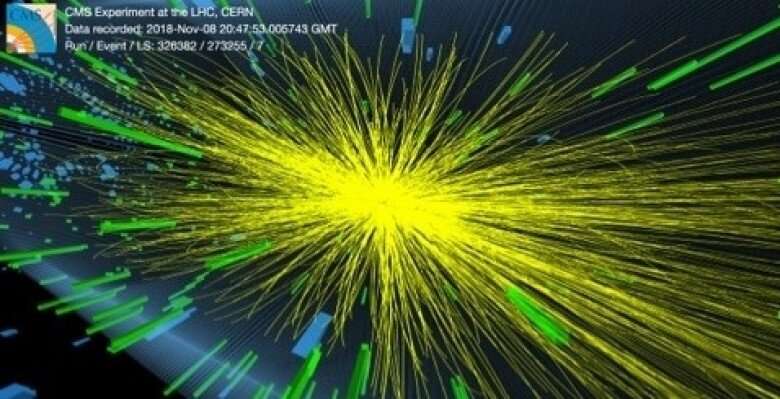 Quark-gluon plasma (QGP) is a state of matter existing at extremely temperatures and densities, such as those that occur in collisions of hadrons (protons, neutrons and mesons).
Quark-gluon plasma (QGP) is a state of matter existing at extremely temperatures and densities, such as those that occur in collisions of hadrons (protons, neutrons and mesons).
Por: Phys.org. Acesse aqui a matéria original.
Under so-called "normal" conditions, quarks and gluons are always confined in the structures that constitute hadrons, but when hadrons are accelerated to relativistic velocities and made to collide with each other, as they are in the experiments performed at the Large Hadron Collider (LHC) operated by the European Organization for Nuclear Research (CERN), the confinement is interrupted and the quarks and gluons scatter, forming a plasma. The phenomenon lasts only a tiny fraction of a second, but observation of it has produced important discoveries about the nature of material reality.
One of the discoveries, evidence for which is steadily accumulating, is that quark-gluon plasma has a fractal structure. When it disintegrates into a stream of particles propagating in various directions, the behavior of the particles in the jets is similar to that of the quarks and gluons in the plasma. Moreover, it decays in a cascade of reactions with a pattern of self-similarity over many scales that is typical of fractals.
A new study, published in The European Physical Journal Plus, describes a mathematical tool with which to understand more about the phenomenon. The authors focus on a technical aspect of the solution to the Klein-Gordon equation for the dynamics of bosons, relativistic particles with zero spin that share the same quantum states and are therefore indistinguishable. In a Bose-Einstein condensate (BEC); moreover, particles that behave collectively as if they were a single particle. BEC research has yielded new atomic and optical physics. Potential applications include more accurate atomic clocks and enhanced techniques to make integrated circuits.
"Fractal theory explains BEC formation," said Airton Deppman, a professor at the University of São Paulo's Institute of Physics (IF-USP) in Brazil, and principal investigator for the study.
"The study was part of a broader research program that had already resulted in 2020 in the article 'Fractals, nonextensive statistics, and QCD' published in Physical Review D, demonstrating that Yang-Mills fields have fractal structures and explaining some phenomena seen in high-energy collisions where quark-gluon plasma is formed," Deppman added. Saiba mais...
Imagem: Cascade of events triggered by colliding lead ions in the LHC’s CMS detector, recorded in November 2018. Credit: CMS/CERN
Imagem: Cascade of events triggered by colliding lead ions in the LHC’s CMS detector, recorded in November 2018. Credit: CMS/CERN

